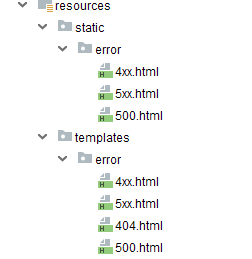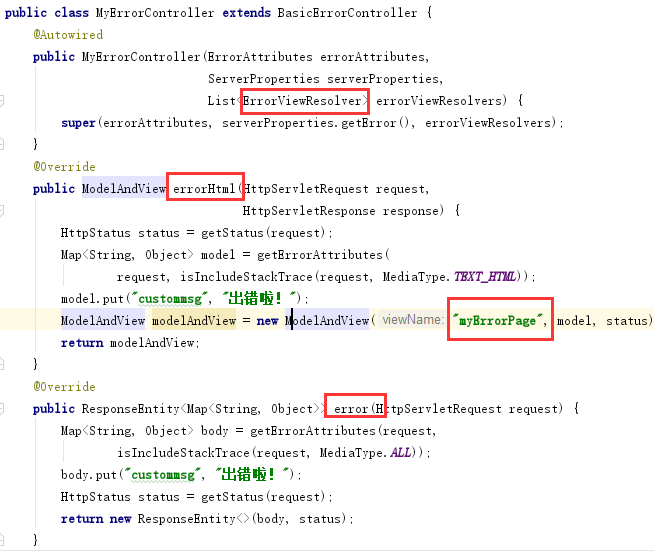目的与原理:
处理异常时,若我们想根据实际情况返回不同的页面,@ControllerAdvice与@ExceptionHandler,一般用于处理应用级别的异常,一些容器级别的错误就处理不了,例如Filter中抛出异常,SpringBoot对于错误会有一个默认页面给用户显示出来,现在我们想显示自己的页面。
SpringBoot在返回错误信息时不一定返回HTML页面,而是根据实际情况返回HTML或者一段JSON,我们可以将这二者自己定制。
SpringBoot中的错误默认是由BasicErrorController类来处理的,这个类核心方法有两个:
@Controller public class MyErrorController extends BasicErrorController { @Autowired public MyErrorController(ErrorAttributes errorAttributes, ServerProperties serverProperties, List<ErrorViewResolver> errorViewResolvers) { super(errorAttributes, serverProperties.getError(), errorViewResolvers); } @Override public ModelAndView errorHtml(HttpServletRequest request, HttpServletResponse response) { HttpStatus status = getStatus(request); Map<String, Object> model = getErrorAttributes( request, isIncludeStackTrace(request, MediaType.TEXT_HTML)); model.put("custommsg", "出错啦!"); ModelAndView modelAndView = new ModelAndView("myErrorPage", model, status); return modelAndView; } @Override public ResponseEntity<Map<String, Object>> error(HttpServletRequest request) { Map<String, Object> body = getErrorAttributes(request, isIncludeStackTrace(request, MediaType.ALL)); body.put("custommsg", "出错啦!"); HttpStatus status = getStatus(request); return new ResponseEntity<>(body, status); } }
errorHtml方法用来返回错误HTML页面,error用来返回错误json,这两个究竟返回哪个,看请求头Accept参数。首先看返回HTML页面的errorHTML方法,通过调用resolveErrorView方法来获取一个ModelAndView。而resloveErrorView方法的调用最终会来到DefaultErrorViewResolver类中,这个类是SpringBoot中默认的错误信息视图解析器。


从DefaultErrorViewResolver类的部分源码中看到,SpringBoot默认是在error目录下查找4xx,5xx的文件作为错误视图,当找不到会回到errorHtml方法中,然后使用error作为默认的错误页面视图名,如果没有名字是error的页面,就会以默认的错误页面显示。
1.简单配置:
controller:

如果我们只是简单使用,直接在/static/error/下创建4xx.html,5xx.html的页面即可,也可以使用响应码直接命名文件若404.html,500.html。

这样只能使用静态HTML页面,无法向用户展示完整的错误信息,使用我们要用模板语言,比如用Thymeleaf模板语言为例,Thymeleaf默认处于classpath:/templates/目录下,如图:

4xx.html <!DOCTYPE html> <html lang="en" xmlns:th="http://www.thymeleaf.org/"> <head> <meta charset="UTF-8"> <title>Title</title> </head> <body> <table border="1"> <tr> <td>timestamp</td> <td th:text="${timestamp}"></td> </tr> <tr> <td>status</td> <td th:text="${status}"></td> </tr> <tr> <td>error</td> <td th:text="${error}"></td> </tr> <tr> <td>message</td> <td th:text="${message}"></td> </tr> <tr> <td>path</td> <td th:text="${path}"></td> </tr> </table> </body> </html>
此时,有一个优先级问题,如以上,响应码.html文件优先于4xx.html文件,动态页面高于静态页面(/templates/与/static/下的同名文件,/templates/下先展示)。
2.复杂配置:
上面的针对HTML页面无法处理JSON定制问题,SpringBoot中支持对Error信息的深度定制:
2.1自定义Error数据
就是对返回的数据进行自定义,SpringBoot返回的Error信息一共5条,分别是timestamp,status,error,message,path。在BasicErrorController的errorHtml和error方法中都是根据getErrorAttributes方法获取Error信息的。
该方法最终会调用DefaultErrorAttributes类的getErrorAttributes方法,而DefaultErrorAttribute类是在ErrorMvcAutoConfiguration中默认提供的。
我们只需要自己提供一个ErrorAttributes即可,DefaultErrorAttributes是ErrorAttributes类的子类,使用我们只需要自己写一个类继承DefaultErrorAttributes即可。

<!DOCTYPE html> <html lang="en" xmlns:th="http://www.thymeleaf.org/"> <head> <meta charset="UTF-8"> <title>Title</title> </head> <body> <table border="1">
<tr> <td>custommsg</td> <td th:text="${custommsg}"></td> //显示自定义数据 </tr>
<tr> <td>timestamp</td> <td th:text="${timestamp}"></td> </tr> <tr> <td>status</td> <td th:text="${status}"></td> </tr> <tr> <td>error</td> <td th:text="${error}"></td> </tr> <tr> <td>message</td> <td th:text="${message}"></td> </tr> <tr> <td>path</td> <td th:text="${path}"></td> </tr> </table> </body> </html>
2.2自定义error视图
自己提供一个类继承ErrorViewResolver即可


2.3完全自定义
前两种都是对BasicErrorController类中的某个环节进行修补,我们可以自己提供一个类实现ErrorController接口。

